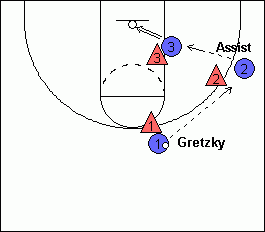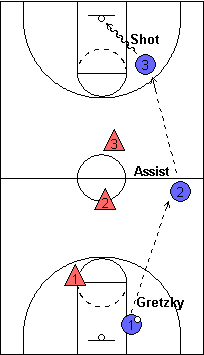Promote Great TEAMWORK and Unselfish Play With This Basketball Passing Statistic (It's NOT an Assist)
A basketball stat that most coaches track is an assist, because it's meant to promote unselfishness. In basketball, an assist is the last pass that leads directly to a basket. An assist is a great statistic to track, but it can still lead to teamwork and turnover problems.
Here are a couple of examples, and I'm sure you could think of a few more:
- A player may hog the ball until he gets a shot for himself or finds an open teammate. That way, he gets an assist or basket to pad his stats. As a result, the ball stops moving and teamwork is destroyed even if an assist is generated.
- A player tries to make the "great" pass to get an assist. This will often result in more bad passes than good passes. The player is trying so hard to get that assist and ends up throwing a pass that is nearly impossible execute.
This would reward those players who..
- Throws a great outlet pass that sets up somebody else for an assist.
- Uses a proper ball fake to get a player out of position in the post before throwing it to another player on the perimeter who has a better passing angle to get the assist.
Recently, while talking to Don Kelbick, he informed me that a coach by the name of Mike Neer from the University of Rochester created this stat and calls it a "Gretzky" referencing hockey legend, Wayne Gretzky.
Mike Neer is one of the most successful college coaches in the nation. He has led his team to a National Championship, 4 Final Fours, and 8 Sweet Sixteens at the Division 3 National Tournament. Rochester also has ridiculously high academic standards.
Don Kelbick put it in perspective for us by saying, "It would be like Harvard winning the national championship."
Criteria for a Gretzky:
- There is no intent to shoot in a Gretzky. A Gretzky involves recognition that A>C>B is safer and more effective than A>B.
There is a dribble Gretzky when a player fakes a pass to B and then dribbles (once or twice) to improve his passing angle to B. A dribble Gretzky can also result in an assist. - Ultimately, it is a pass fake and pass to a 3rd player that makes a Gretzky. This is different than penetrate and pitch and any subsequent passes which involve a threat to shoot.
Here are a few specific situations that a Gretzky would be counted.

- A player has the ball at the top of the key and recognizes that the offensive player had an advantage in the post. Instead of trying to force
the ball into the post which results in many turnovers, the player fakes a pass into the post and passes to the player on the wing who has a better
passing angle. The player on the wing dumps the ball into the post for a basket.
The player at the top of the key would be credited with the "Gretzky" and player on the wing would be credited with an "Assist."

- A post player gets the defensive rebound. The rebounder recognizes a player streaking down the court, but realizes it would be safer to outlet the ball to
another guard. Then, the guard throws the ball to the streaking player for a lay up.
The post player would be credited with the "Gretzky" and the player who received the outlet pass would be credited with the "Assist."
- Improving team unselfishness.
- Improving teamwork.
- Encouraging players to make the easy pass.
So, introduce and start tracking "Gretzkys" and watch how it will improve your team's teamwork and unselfish play!
You can also read more on this subject at this link: https://www.breakthroughbasketball.com/blog/index.php/gretzky-basketball-passing-statistic/
This is an email conversation between Coach Mike Neer and myself.
Related Pages & Helpful Resources
Breatkhrough Stats App - Track Stats on Your iPad
Basketball Statistics - Using Stats
Tracking Your Defensive Statistics And Performance
What do you think? Let us know by leaving your comments, suggestions, and questions...
|
||||||||||||||||||||||||



 Facebook (145k Followers)
Facebook (145k Followers) YouTube (152k Subscribers)
YouTube (152k Subscribers) Twitter (33k Followers)
Twitter (33k Followers) Q&A Forum
Q&A Forum Podcasts
Podcasts